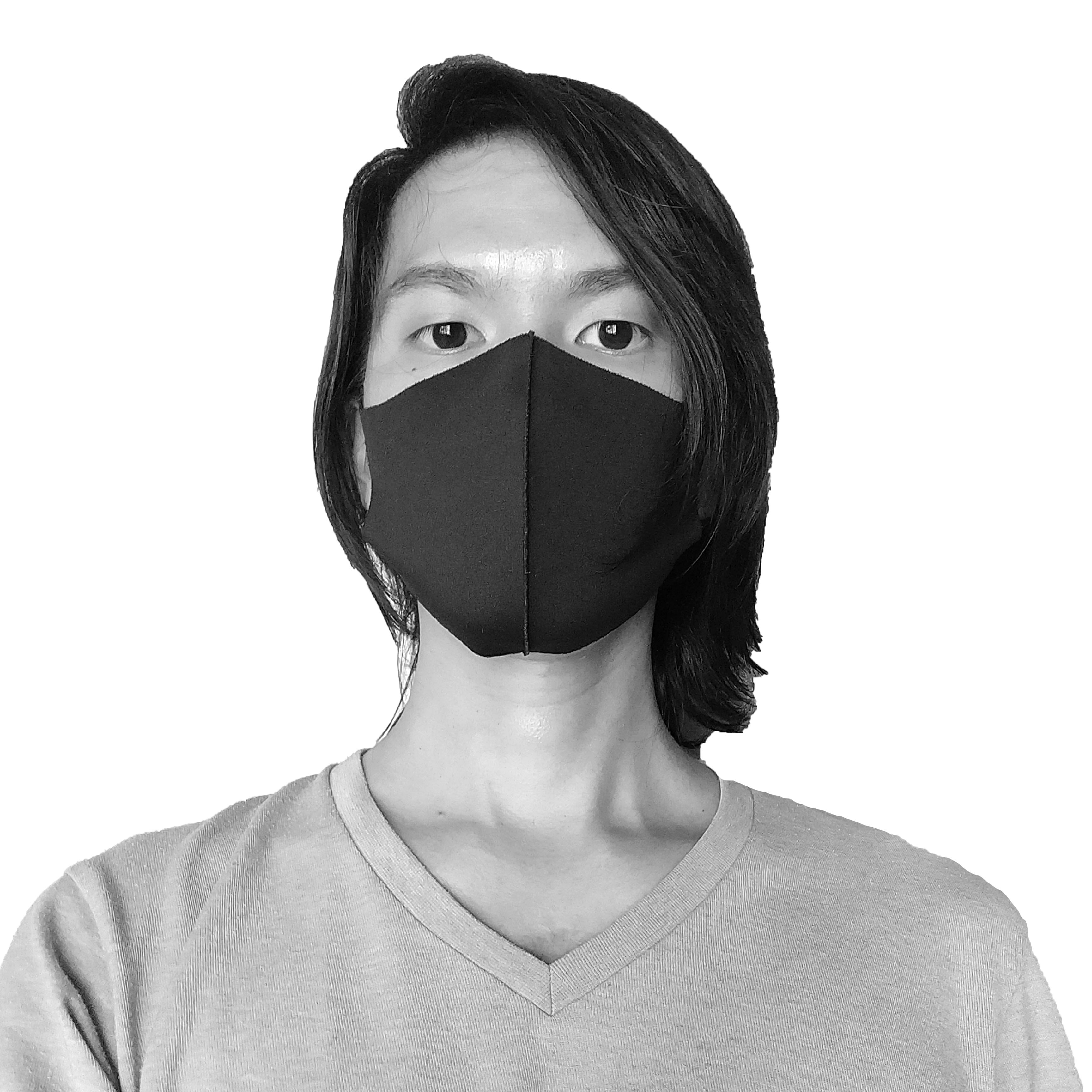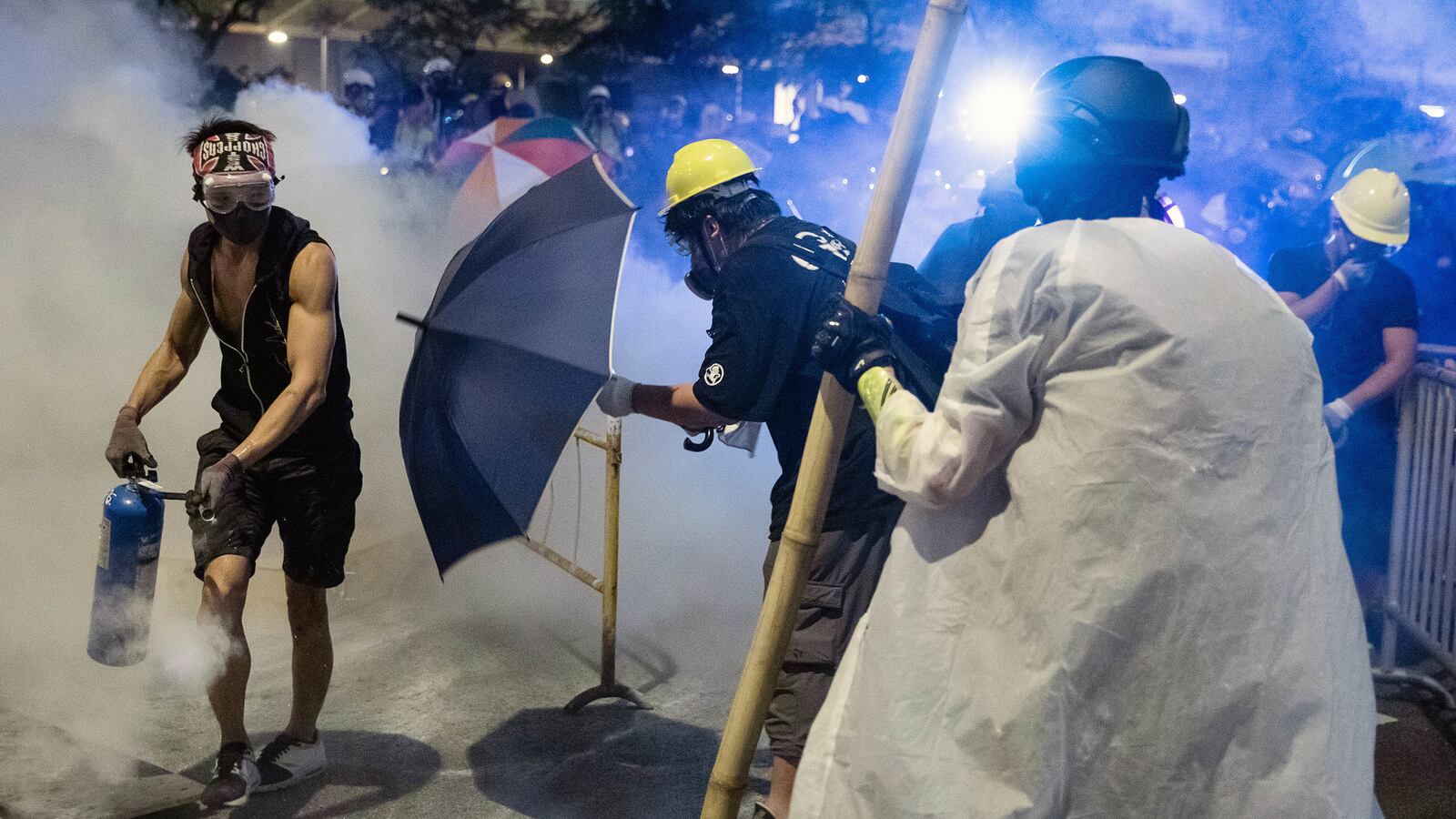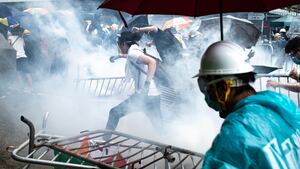HONG KONG—China’s military, the People’s Liberation Army, is ready to sow fear.
Late on Wednesday evening, it released a video featuring armored vehicles and tanks, as well as the Chinese Communist Party’s troops performing a drill to crack down on protesters. They scale a building, storm a residence, and rappel from a helicopter. They board and take control of a ship, and snipe from a hill.
In one scene, an officer speaks in Cantonese—the language spoken in Hong Kong, instead of the more broadly used Mandarin—yelling, “All consequences are at your own risk!”
The message clearly is intended for people here, but unrest persists on the streets, at times erupting without premeditation. And one phrase has been heard on the lips of many thousands of people, if not millions, in this city: “Liberate Hong Kong, the revolution of our time.”
Those same words are graffitied on walls across the city and scribbled on banknotes. They’re printed on flyers that are handed out, and seen on posters that are glued to lampposts. Some of the CCP’s advisors take those words to mean mutiny is here and say a “color revolution” is unfolding in Hong Kong. The Party’s apparatchiks have even claimed openly that the United States is the adversary behind it all.
Those interpretations have translated into nervous-making developments. Although a military commander of the People’s Liberation Army told a Pentagon official in early July that the CCP’s troops will not mobilize in Hong Kong to quell the unrest, Bloomberg reported on Wednesday that a White House official said Chinese security forces are massing near the border between Hong Kong and mainland China.
The unnamed White House official’s statement coincided with protesters surrounding police stations in different parts of the city. They did this in response to news that 44 people who have been arrested were being formally charged with “rioting.” Among those facing legal consequences, the youngest is 16 years old. Fourteen of them are students.
At one of the police stations where people gathered after dark on July 30, a police sergeant was seen brandishing his shotgun, aiming it at the crowd, finger on the trigger, after he was surrounded by protesters. Later at night, a car drove by and launched fireworks at those who were present.
The protests were sparked at first by Hong Kong Chief Executive Carrie Lam’s attempt to introduce a bill that, if enacted into law, would provide cover for politically motivated extradition to mainland China. Though the bill has been abandoned for now, protesters in Hong Kong have consistently voiced their dissatisfaction with Lam—who is seen as the CCP’s stooge rather than a leader of the city—as well as the police force, which has been tagged as a corrupt organization that has linked up with triad gangs to beat people into submission.
CCP bureaucrats and policy wonks see the popularity among demonstrators of “liberate Hong Kong, the revolution of our time” as a particular cause for alarm. Those words originally were a 2016 campaign slogan for Edward Leung, a local figure who was running for a seat in the legislature. He eventually was disqualified from the election due to his view that Hong Kong should seek independence from CCP governance.
Last year, Leung was sentenced to six years in prison for assaulting a police officer and “rioting”—the same charge faced by protesters who were detained in July.
Leung’s words, now that they have been adopted by Hongkongers as a rallying cry, unify various camps in their anti-government, anti-police street actions. But the CCP and its supporters in Hong Kong glean from the slogan the reemergence of an independence movement that was quickly contained and expunged from Hong Kong’s mainstream political landscape nearly one year ago, when a political party advocating for the city’s separation from China was outlawed.
Meanwhile, Hong Kong lawmaker Junius Ho, who was previously seen liaising with the thugs who beat Hongkongers at a train station—even calling them “heroes”—spoke with China’s hyper-nationalist, state-run media outlet Global Times, saying, “The PLA can intervene to bring back peace and stabilize the political situation in Hong Kong as per the law.”
Taking his Party loyalist cosplay even further, Ho also appropriated Beijing’s talking point that foreign entities are to be blamed, saying, “I am not afraid of dark forces and their interference . . . Let’s break all the dark forces together.”
On Monday, the CCP’s top organ that manages matters in Hong Kong held a press conference in Beijing to address the ongoing dissension. Speaking on behalf of the Hong Kong and Macau Affairs Office, a State Council spokesperson described the city as a place of “chaos,” dismissed the links between the Hong Kong Police Force and triad gangs as rumors (despite photos and videos telling us otherwise), and then stated Beijing’s “resolute support” for Carrie Lam and her office.
The next day, the spokesperson of China’s Ministry of Foreign Affairs, Hua Chunying, called Hong Kong’s black-shirt protesters “radical violent elements,” then said unrest in the city is the “handiwork” of the United States and that “American faces” have been appearing within the crowds.
Hua’s statements echoed reports by pro-Beijing media channels that said a “foreign commander” was spotted disseminating information about police movements. In actuality, the man in question is a New York Times employee who was communicating with his colleagues.
Though Hua was speaking on behalf of a governmental agency whose chief responsibility is foreign relations, her words were meant for a domestic audience. Chinese officials and state-run media repeatedly have painted Hong Kong’s black-shirt protesters as hooligans and “traitors” who are acting on behalf of foreign—that is, American—powers, instead of examining the domestic issues that have enraged Hongkongers.
The People’s Liberation Army has maintained a garrison in Hong Kong since July 1997, when China reclaimed sovereignty over the city. Since then, up to 10,000 troops have been stationed in Hong Kong on any given day, and PLA exercises are conducted regularly in Shenzhen. Following Bloomberg’s report, Xinhua said 190,000 police officers, as well as armored vehicles and helicopters, were taking part in a drill ahead of celebrations for the 70th anniversary of the founding of the People’s Republic.
In any case, the State Council’s unprecedented public statement about the situation in Hong Kong signaled that Lam’s government is no longer in charge of running the city’s affairs—Beijing is. The fig leaf has dropped to the ground.
Even so, the protesters’ ire remains focused on figures within the city. Rallies against Carrie Lam and the Hong Kong Police Force continue to take place two or three times a week. Thousands of mothers meet on some Friday evenings in a public park. A march involving the elderly took place in mid-July. Last week, 15,000 black-shirts occupied part of Hong Kong’s airport for half a day, with aviation workers joining in. There was no violence at these events. There was only one difference between these incidents and others where clashes unfold—the police weren’t there. Things only get rough when the uniforms or organized thugs show up.
Beijing has sent a clear message that it expects Lam to return Hong Kong to its status quo, starting by doling out punishment to the 44 people detained. All but one appeared in court on Wednesday and then were released on bail. They’re under curfew and must remain at home between midnight and 6 a.m., except for a pilot who received an exemption for professional reasons and an individual who works night shifts at a children’s home.
A little more than a week ago, thugs dressed in white entered a train station and beat up anyone dressed in black—as well as people who were simply passing by, like families with children and two pregnant women. At the time, police let all of them go, but later arrested 12 men after mounting public criticism. All were released with no charges.
At the moment, trust between Hong Kong’s citizenry and the police force is essentially nonexistent. Hongkongers have witnessed what they once saw as an instrument of social order transition to become a political accessory, one which contains members that call the protesters “cockroaches” and threaten to perform “headshots.”
Individuals from various sectors—legal professionals, medical professionals, educators, athletes, and many more—have voiced their discontent with how the chief executive and police force have been responding to Hongkongers. Churches and mosques across the city offer overnight shelter for those who can’t get home when they try to evade the police.
Even hundreds of civil servants from more than 30 governmental bodies, including high-ranking public administrators, have issued open letters to call out Carrie Lam’s incompetence and lack of leadership. The bureaucrats, who are normally publicity-shy, are organizing their own rally on Friday evening to speak out against Lam and the police force.
Reports in Chinese state-run media say the police in Hong Kong will restore law and order. But with poor training, the cops lean on their tools instead of technique to disperse crowds, setting out to bash heads and settle grudges. The police force is about to have a new tool to use, too: they’re conducting road tests for trucks equipped with 15 water cannons each. The vehicles will be deployed as early as mid-August.
As Beijing watches the protests in Hong Kong escalate, the CCP’s top leaders and advisors are about to head to Beidaihe, a seaside resort town east of Beijing where they meet once a year to set their geopolitical and domestic agendas. Two matters will surely be at the top of the list: Donald Trump’s trade war and Hong Kong’s uncertain future.
In some eyes, the latter problem, “the revolution of our time,” is aching for a military solution.








